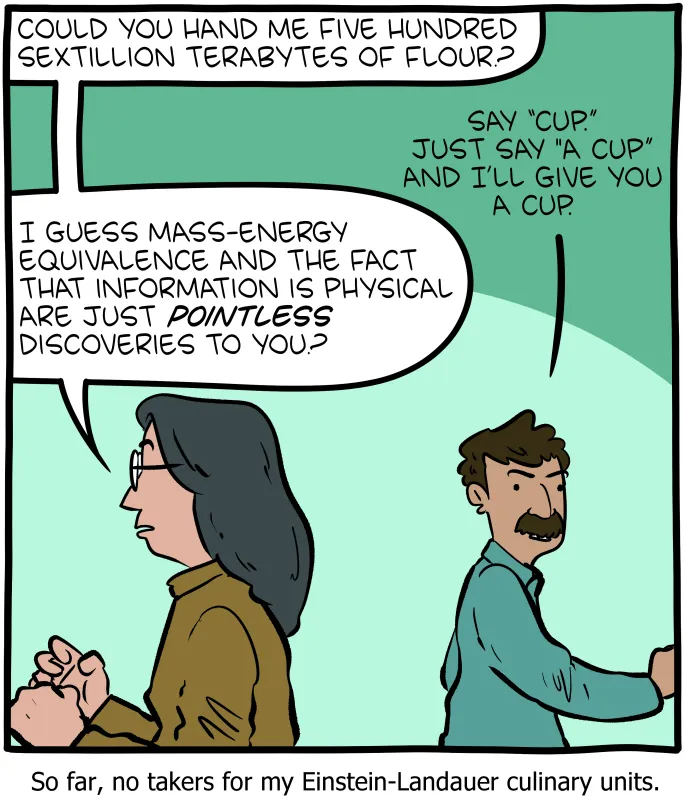That doesn't work anyway, since based on wheat variety, growing season, and grinding method, different flours have different information density.
Science Memes
Welcome to c/science_memes @ Mander.xyz!
A place for majestic STEMLORD peacocking, as well as memes about the realities of working in a lab.

Rules
- Don't throw mud. Behave like an intellectual and remember the human.
- Keep it rooted (on topic).
- No spam.
- Infographics welcome, get schooled.
This is a science community. We use the Dawkins definition of meme.
Research Committee
Other Mander Communities
Science and Research
Biology and Life Sciences
- !abiogenesis@mander.xyz
- !animal-behavior@mander.xyz
- !anthropology@mander.xyz
- !arachnology@mander.xyz
- !balconygardening@slrpnk.net
- !biodiversity@mander.xyz
- !biology@mander.xyz
- !biophysics@mander.xyz
- !botany@mander.xyz
- !ecology@mander.xyz
- !entomology@mander.xyz
- !fermentation@mander.xyz
- !herpetology@mander.xyz
- !houseplants@mander.xyz
- !medicine@mander.xyz
- !microscopy@mander.xyz
- !mycology@mander.xyz
- !nudibranchs@mander.xyz
- !nutrition@mander.xyz
- !palaeoecology@mander.xyz
- !palaeontology@mander.xyz
- !photosynthesis@mander.xyz
- !plantid@mander.xyz
- !plants@mander.xyz
- !reptiles and amphibians@mander.xyz
Physical Sciences
- !astronomy@mander.xyz
- !chemistry@mander.xyz
- !earthscience@mander.xyz
- !geography@mander.xyz
- !geospatial@mander.xyz
- !nuclear@mander.xyz
- !physics@mander.xyz
- !quantum-computing@mander.xyz
- !spectroscopy@mander.xyz
Humanities and Social Sciences
Practical and Applied Sciences
- !exercise-and sports-science@mander.xyz
- !gardening@mander.xyz
- !self sufficiency@mander.xyz
- !soilscience@slrpnk.net
- !terrariums@mander.xyz
- !timelapse@mander.xyz
Memes
Miscellaneous
They have an international prototype sack of flour in an old missile silo in Kansas. Ultimately that's what all the measurements are relative to
Computational biochemists are working with a crack team of mathematicians as we speak to develop an alternative standard which does not need a reference mass
I like to read bedtime stories to my wheat, so it learns more and has higher information density
I just plug mine into USB ports
Sounds like the culinary world would benefit from having a measurement system that accounts for these factors.
Wouldn't this make the units temperature-dependent?
Landauer limit is one kTln2 per bit of information, so at 300K about 3 zeptojoule per bit.
Dividing by c² we get 32 micro-quectogram per bit, so 32 yoctogram per terabit. 256 yoctogram per terabyte.
The Author wants half a septillion terabytes, 0.5•10²⁴ terabytes, half a yotta-terabyte.
That makes 128 grams.
Since I don't know what on earth "a cup of flour" is, I can't judge if the comic character proposes a reasonable conversion, but 0.1kg seems like a reasonable amount to use in cooking.
For baking I would rather have my units temperature dependent than density dependent (I can compact my flour or work with water or nuts, all having different densities, but my room temperature will always be roughly 300).
I endorse einstein-landauer units.
184 grams is a touch high for "a cup of flour", but I'm not gonna check your math, and the comic probably wanted to use "close enough" round-ish numbers. The weight of a cup of flour is usually somewhere between 120g and 145g, going by the conversions used by major baking recipe publishers like King Arthur, Cooks Illustrated, Washington Post, New York Times, etc.
I fear their apartment is at -50°C and this is a cry for help.
At least I am relieved to know that even acclaimed authors native to the cup-measurement system don't know what "a cup of flour is".
I'll be off baking my pannenkoek with 150g of flour then.
I figured it out. Typed the ln2 into my text and then forgot it in the calculator.
Great, I'ma redo alll my numbers then rq
Information is physical? I'm gonna need a source on that one.
The idea is that information must have a physical representation. But I don't know how that would lead to a standardized mass of a byte.
No, you missed the point. See @milicent_bystandr@lemm.ee's comment and link to Landauer's Principle, the namesake of which is literally named in the title of the post.
TL;DR: Storing information requires a change in entropy. A change in entropy requires a change in energy. There must be a minimum non-zero amount of energy required for a given quantity of information. Energy is mass due to mass-energy equivalence. ∴ information has mass independent of its physical representation.
There must be a minimum non-zero amount of energy required for a given quantity of information.
Okay, but I still don't get how that leads to a standardized measure of energy/mass for a given amount of bytes. That seems to be the premise of the comic.
information has mass independent of its physical representation.
So what is the mass of a byte of 'pure' information? And how do you derive it?
So what is the mass of a byte of ‘pure’ information? And how do you derive it?
That's all in the linked wikipedia article, but since you asked:
At room temperature, the Landauer limit represents an energy of approximately 0.018 eV (2.9×10^−21^ J).
That's 1 bit, so 1 byte is eight times that, which you can plug into E=mc^2^ to get its absurdly small equivalent mass.
It's important(?) to note that Landauer's Principle is not settled science and has yet to be rigorously proven, unless there's some recent development which the comic is referencing. I haven't checked.
That’s all in the linked wikipedia article
I appreciate you spelling some of it out, because I'm just curious and don't have the background knowledge to really navigate this.
When referencing another person's comment, it can be helpful to link to that comment or the article you mentioned.
I'd also like to point out that many Wikipedia articles, particularly those written by experts on a given scientific subject, tend to be daunting rather than helpful for people not yet familiar with that subject.
Explanations like the one you offered in this comment and the next reply can help make topics more approachable, so I very much appreciate that.
To illustrate my point:
In this case, the article first describes the principle as "pertaining to a lower theoretical limit of energy consumption of computation", which doesn't directly highlight the connection to information storage. The next sentence then mentions "irreversible change in information" and "merging two computational paths", both of which are non-trivial.
From a brief glance at the article on reversible computing linked further on, I gather that "irreversible" here doesn't mean "you can't flip the bit again" but rather something like "you can't deterministically figure out the previous calculation from its result", so the phrase boils down to "storing a piece of information" for our context. The example of "merging computational paths" probably has no particular bearing on the energy value of information either and can be ignored as well.
Figuring out the resulting logic that you so kindly laid out – again, thank you for that! – requires a degree of subject-specific understanding to know what parts of the explanation can be safely ignored.
Of course, experts want to be accurate and tend to think in terms they're familiar with, so I don't fault them for that. The unfortunate result is that their writings are often rather intransparent to laypeople and linking to Wikipedia articles isn't always the best way to convey an understanding.
Entropy in information theory is equivalent to entropy in quantum dynamics / thermodynamics

i will Physically bitchslap you then you can deduce yourself the information about whether your face hurts or not, ayy lmao.
At least that's how I choose to interpret this new information
I’d give a source but it’s physically in my house and it’s heavy
Oh sure, throw a fit — just wait until you want to convert those units to kilojoules!
Who's laughing now, tablespoons?!
Hundred sextillion terabytes. Yeah, everybody of calling it hungry sex bites in minutes.
I have absolutely no understanding of whatever is said here
Metric appears to end at 10^30, but even then, I think the better way to phrase that number would be 5,000 quetta-bytes
Tera = 10^12; ~~Septillion~~ Sextillion = 10^21
Source
*500 000 quettabytes
*Sextillion = 10^21 ( = Zetta)
I'd recommend wikipedia here, your source seems to have taken 3 years to update their table and their image is still outdated.
They likely didn't use quetta because it was only added 3 years ago, and is still not widely known. Or maybe it sounded better.
